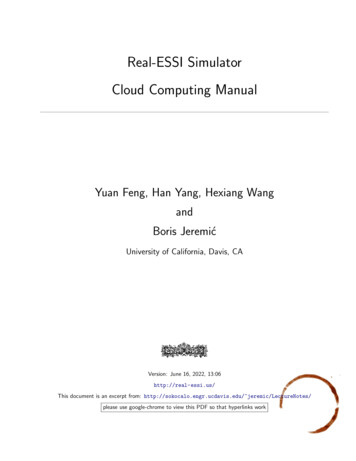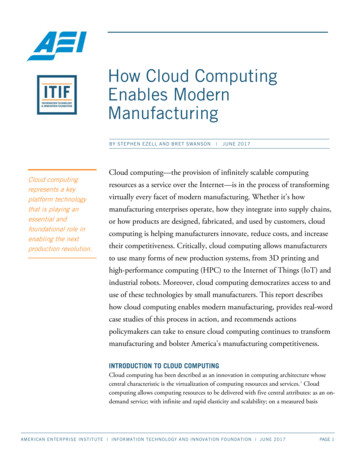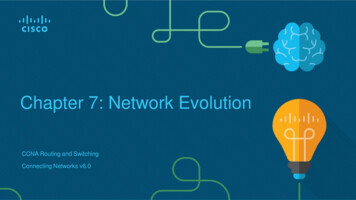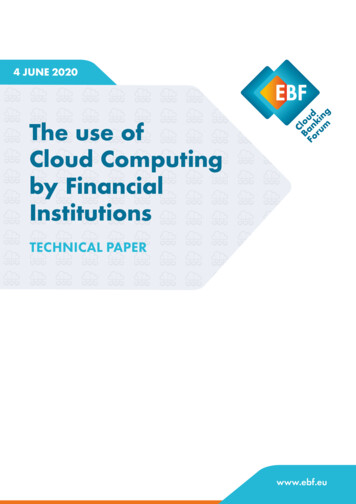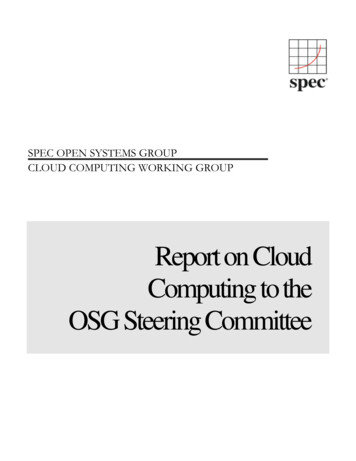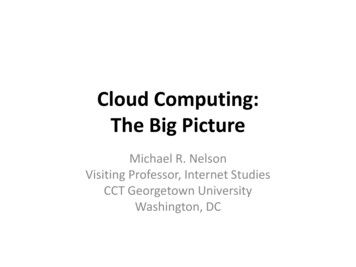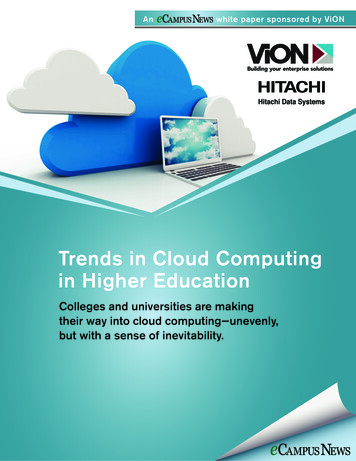
Transcription
Anwhite paper sponsored by ViONTrends in Cloud Computingin Higher EducationColleges and universities are makingtheir way into cloud computing—unevenly,but with a sense of inevitability.
Trends in Cloud Computing in Higher EducationHow are higher education institutions using cloud computing? Which services and applications aremost popular? How do institutions pay for cloud services? What benefits and challenges do technologydecision-makers and purchasers see as they move to the cloud? What are their plans for the near future?To answer these questions, eCampus News conducted an online survey of key technology decisionmakers and purchasers in higher education institutions. The survey, sponsored by ViON Corporation,gathered information from people in leadership roles including chiefs, directors, and managers ofinformation technology (IT), information systems (IS), and academic or educational technology.Respondents came from public and private four-year liberal arts colleges, community or technicalcolleges, and research universities of all sizes: Small (under 2,500 students) Mid-sized (2,500 to 5,000 students) Large (5,000 to 10,000 students)“Cloud computing is thedirection IT is going in.”—Survey respondent Largest (over 10,000 students)While respondents from all types and sizes of institutions showed some similarities in their perceptions ofthe cloud and cloud usage, there are some notable differences that are highlighted in the key findings.88%of respondents rate their knowledge ofcloud computing as high or moderate,including 27 percent who agree that “I’m among thecloud experts at my institution” and 61 percent whoagree that “I know enough to have an intelligentconversation about cloud computing.”2http://www.vion.com
Trends in Cloud Computing in Higher EducationKEY FINDINGS1. Software as a Service (SaaS) is by far the most commonly used cloud computing service inhigher education. Almost eight in 10 respondents (79 percent) report that their institutions are usingSaaS. That’s about twice as many as the roughly four in 10 respondents (39 percent) who report thattheir institutions use Infrastructure as a Service (IaaS).Communications as a Service (CaaS), cited by 22 percent of respondents, and Platform as a Service(PaaS), cited by 18 percent, are less commonly used, as shown in Figure 1.Respondents from mid-sized institutions say that their institutions are significantly more likely not touse certain types of clouds than their colleagues from larger institutions. Twenty-three percent ofrespondents from mid-sized institutions report they do not use SaaS (compared to only 8 percent fromthe largest institutions), while 80 percent of respondents from mid-sized institutions say they do notuse PaaS (compared to 45 percent of respondents from large institutions).Defining TermsSurvey respondents were provided with these definitions about cloud computing services: Software as a Service (SaaS)—Software distribution model in which applications arehosted by a vendor or service provider and made available to customers over a network,typically the Internet. Infrastructure as a Service (IaaS)—Outsourcing the equipment used to supportoperations, including storage, hardware, servers, and networking components. Communications as a Service (CaaS)— CaaS builds on the basic foundation of Softwareas a Service (SaaS), with some requirements unique to communications applicationsincluding voice over IP (VoIP or Internet telephony), instant messaging (IM), collaborationand videoconference applications using fixed and mobile devices. Platform as a Service (PaaS)—A method for delivering operating systems and associatedservices over the Internet without downloads or installation.3http://www.vion.com
Trends in Cloud Computing in Higher EducationFigure 1. Most Higher Education Institutions Use SaaSSoftware as a Service (SaaS)Communications as a Service (CaaS)YES22%YES 79%NO 13%Don’tknow17%NO 61%Don’t know 8%Q. Are you using Softwareas a Service (SaaS)?Infrastructure as a Service (IaaS)YES 39%Don’tknow12%NO 49%Q. Are you using Infrastructureas a Service (IaaS)?Q. Are you using Communicationsas a Service (CaaS)?Platform as a Service (PaaS)YES18%Don’tknow19%NO 63%Q. Are you using Platformas a Service (PaaS)?4http://www.vion.com
Trends in Cloud Computing in Higher Education2. Higher education institutions are using the cloud to manage a wide range of technology,administrative, and educational systems, from nuts-and-bolts services to more innovativeapplications:Software as a Service (SaaS). Email is the most popular software application in the cloud, cited by66 percent of respondents who say their institutions use SaaS, followed by learning managementsystems and productivity tools, cited by 55 percent and 42 percent, respectively, as shown in Figure 2.Figure 2. Top Three SaaS ApplicationsEmail66%Learning management system55%Productivity tools42%Q. What applications do you use for SaaS? (Check all that apply.)SaaS usage covers a variety of other applications as well, according to respondents who say their institutions use SaaS: Customer relations management (CRM) (27 percent) Human resource management (25 percent) Video management (23 percent) Content management (21 percent) Student information system (SIS) (20 percent) Curriculum applications (15 percent) Accounting tools (11 percent) Data management (11 percent) Research applications (10 percent) Management information systems (9 percent)Four-year liberal arts colleges are significantly more likely to use cloud CRM applications than otherinstitutions, with 37 percent of respondents whose institutions use SaaS citing CRM use, compared to17 percent of these respondents from community or technical colleges and 13 percent from researchuniversities. On the other hand, four-year liberal arts colleges are significantly less likely to use cloudmanagement information systems, cited by only 2 percent of these respondents, than either researchuniversities (17 percent) or community or technical colleges (14 percent).5http://www.vion.com
Trends in Cloud Computing in Higher EducationDifferences in SaaS usage show up as well between small institutions and the largest institutions, according to respondents in institutions that use SaaS. Small institutions are more likely to use a cloudstudent information system (SIS), with 39 percent of respondents reporting this use, compared to 16percent in the largest institutions. Cloud-based video management is more prevalent in small institutions as well, with 39 percent of respondents citing this use, compared to 12 percent in the largest institutions. Conversely, respondents in the largest institutions report greater use than those in smallinstitutions of cloud-based human resource management (by a margin of 35 percent to 10 percent)and management information systems (by a margin of 16 percent to 0 percent). All of these differences are statistically significant.In open-ended comments, individual respondents also volunteered other applications their institutionshave migrated to the cloud, including: IT service management (ITSM) Project, service, resource, finance, talent, scholarship, student event, and vehicle fleet management Document imaging, health center operation, bookstore operation, residential life system, careerservices, development, and foundation and planned givingInfrastructure as a Service (IaaS). Respondents from institutions that use IaaS report that servers(66 percent) and data storage (63 percent) are the most popular services. Thirty-one percent of theserespondents also report the use of cloud hardware services, as shown in Figure 3, while 18 percentsay their institutions use cloud networking services.In open-ended comments, one respondent noted the use of IaaS for disaster recovery (DR) services.Figure 3. Top Three IaaS ServicesServers66%Data Storage63%Hardware31%Q. What applications do you use for IaaS? (Check all that apply.)Communications as a Service (CaaS). Respondents from institutions that use CaaS report thatweb conferencing (65 percent) and collaboration tools (60 percent) are the most widely used communications applications in the cloud. Videoconferencing and social media tools, each cited by 49 percent of these respondents, and instant messaging, cited by 46 percent, are other communicationsapplications rounding out the top five CaaS applications, as shown in Figure 4. Thirty-seven percent ofrespondents also say their institutions use VoIP/Internet telephony; 11 percent cited call center/techsupport.6http://www.vion.com
Trends in Cloud Computing in Higher EducationFigure 4. Top Five CaaS ApplicationsWeb conferencing65%Collaboration tools60%Videoconferencing49%Social media tools49%Instant messaging46%Q. What applications do you use for CaaS? (Check all that apply.)In open-ended comments, individual respondents noted that their institutions are using CaaS foremergency notification systems and as a mass communications tool (bulk emails and texts).Platform as a Service (PaaS). By far, the operating system is the top feature that institutions usingPaaS contract out to the cloud, cited by 70 percent of respondents from these institutions. Roundingout the top four applications are server software (cited by 48 percent of these respondents), storage(44 percent), and hosting (41 percent) as shown in Figure 5. About one-third of institutions that usePaaS are using it for database management (cited by 33 percent of these respondents), support (33percent), and network access (30 percent), and about one-quarter use PaaS for server-side scriptingenvironment (26 percent) and tools for design and development (26 percent).Figure 5. Top Four PaaS FeaturesOperating system70%Server software48%Storage44%Hosting41%Q. What features do you use for IaaS? (Check all that apply.)7http://www.vion.com
Trends in Cloud Computing in Higher Education3. For every type of cloud computing in higher education, the dominant model is a privatecloud funded by operating expenses. Most institutions prefer to keep their cloud applications,services, and equipment private, although the findings make clear that institutions also tend to usemore than one type of cloud—private, public, and hybrid—for different services and applications. Fewuse community clouds. Table 1 shows the breakdowns in usage for each type of cloud, based onsurvey responses. Notably, about one in 10 respondents, on average, doesn’t know what type of cloudtheir institutions use for cloud computing.Table 1. Private Clouds Dominate for All Types of Cloud e for CaaS?13%Q.Don’tWhatknowapplications do you(Check all11%that apply.) 12%According to survey respondents, most higher education institutions pay for cloud services,applications, and equipment out of operating expenses, not capital expenses, as shown in Table 2. Inopen-ended comments, a few respondents indicated that their institutions use both operating andcapital expenses to pay for cloud computing. Notably, substantial percentages of respondents don’tknow how their institutions pay for cloud computing.Table 2. Most Institutions Pay for Cloud Computing as an Operating ExpenseSaaSIaaSCaaSPaaSOperating expenses76%72%63%84%Capital expenses5%9%9%8%Don’t know19%19%29%8%8http://www.vion.com
Trends in Cloud Computing in Higher Education4. Key technology decision-makers and purchasers in higher education see both benefitsand challenges with cloud computing. Survey respondents cited the top two benefits of cloudcomputing as access of use (63 percent) and mobility (62 percent). At least half of respondents alsoreported that automatic updates and patch management, cost savings, and efficiencies of scale arebenefits. The full list of potential benefits and responses is shown in Figure 6.Figure 6. Benefits of Using the CloudAccess of use63%Mobility62%Automatic updates and patch management53%Cost savings52%Efficiencies of scale51%Easier administration43%Collaboration34%Improved resource allocation30%Improved communication16%Compatibility13%Don’t know3%Q. What are the benefits of using the cloud?Respondents from community and technical colleges (66 percent) are more likely than those fromfour-year liberal arts colleges (42 percent) to report cost savings and improved resource allocation(41 percent to 23 percent) as benefits. Respondents from research universities are more likely thanthose from four-year colleges to report efficiencies of scale as a benefit, by a margin of 65 percent to42 percent. All of these differences are statistically significant.Respondents from small institutions (72 percent) are significantly more likely than those from thelargest institutions (52 percent) to view mobility as a benefit of the cloud.On the flip side, respondents reported plenty of challenges with cloud computing as well. Security topsthe list, cited by 68 percent of all respondents, followed by data ownership (52 percent), limitedcustomization (45 percent), and privacy (41 percent). At least one-third of respondents reported thatgovernance, ease of switching vendors, offsite (offshore) data storage, contract issues, and compliance arechallenges as well. The full list of potential challenges and responses in the survey are shown in Figure 7.9http://www.vion.com
Trends in Cloud Computing in Higher EducationFigure 7. Security Is the Top Challenge with Cloud ComputingSecurity68%Data ownership52%Limited customization45%Privacy41%Governance38%Ease of switching vendors37%Offsite (offshore) data storage37%Contract issues36%Compliance34%Vendor n’t know5%Q. What are the challenges or problems with using cloud services?When it comes to the challenges, differences emerge in the perceptions of respondents fromcommunity and technical colleges and those from four-year liberal arts colleges. Fifty percent ofcommunity and technical college respondents cite contract issues as a challenge, compared to 29percent from liberal arts colleges. Forty-six percent of community and technical college respondentscite compliance as a challenge, compared to 35 percent from liberal arts colleges; and 18 percent ofcommunity and technical college respondents cite upkeep as a challenge, compared to 4 percent fromliberal arts colleges. All of these differences are statistically significant.10http://www.vion.com
Trends in Cloud Computing in Higher EducationVoices from the FieldKey Benefits of Cloud Computing“Cloud computing makes it easier to start or try something without a largeinvestment in infrastructure.”“The primary drivers of cloud computing for us are agility and flexibility.”“The three primary (current) benefits are scalability, price, and security.”“Cost assurance, secure management, reliability, service that cannot beprovided in-house, compliance.”“One of the factors we are looking at is the lack of need to provideinfrastructure for backup-related services for services we put in the cloud.”“Most cloud SaaS has been to improve the ability of our teams to useinformation from our SIS [student information system]. Most cloud IaaShas been to support research or to provide a sandbox for tech development.”Key Challenges of Cloud Computing“Security in the fact that it’s easy for constituents to use cloud serviceswithout the proper vetting of contracts, data ownership, etc.”“Concerns about compromising data or information shared in the cloudbeing shared or leaked.”“Your business processes are at the mercy of the vendor. Unless you have avery good lawyer to negotiate the SLA [service-level agreement] that placesthe financial penalties on the cloud vendor for your loss of business due tothe defect of their product or lack of response—essentially make them feelyour pain—there is no guarantee that they will be responsive to yourbusiness outages.”“Cost is a challenge. SaaS always costs more.”“Many times our vendors have outages—either planned or unplanned—withoutletting us know. Since many of our users have no idea that the software iscloud-based, or even what that means, it is hard to explain that we are at themercy of our vendors and have no control over when issues will be resolved.”11http://www.vion.com
Trends in Cloud Computing in Higher Education5. Looking ahead, many higher education institutions plan to increase their use of cloud computing services or applications—but budget is a limiting factor. A majority of survey respondents(63 percent) reported that their institutions plan to expand to new cloud computing services or applications over the next three years. Still, about one in five respondents (21 percent) said that their institutions plan to cut back on their cloud services—and individual respondents said they plan to bringsome services back in-house.Other institutional plans respondents report for the future: Moving to different services (45 percent) Making connectivity enhancements (33 percent);a number of individual respondents commented thatthey plan to increase bandwidth“We’re seeking a 5–6percent budget increaseeach year.”—Survey respondent Changing how they budget (28 percent)Budget is, in fact, the predominant limiting factor for higher education institutions for expanding theircloud services, according to 69 percent of respondents. Other limiting factors they cited: Internal expertise (33 percent) Compliance issues (28 percent) Vendors (25 percent) Resource allocation (20 percent) Timing (16 percent) Concerns about platform (19 percent) Pushback from stakeholders (16 percent) Bad experience with using cloud services (15 percent)“We are using a ‘cloud first’ strategy—if it makessense to move to the cloud, we are considering it forERP [enterprise resource planning] and CaaS.”—Survey respondent12http://www.vion.com
Trends in Cloud Computing in Higher EducationABOUT THIS SURVEYeCampus News deployed this online survey in March and April 2015 to 8,074 subscribers ofeCampus News magazine and online newsletters, yielding 254 complete responses. All respondentsare key technology decision-makers and purchasers in higher education institutions. The surveysample population by type and size of institution is shown in Table 3. The sample population is notnecessarily representative of all higher education institutions. Not all findings are statisticallysignificant. Where noted, statistically significant differences are reported at the 95 percentconfidence level (p .05).ABOUT VIONThis survey was sponsored by ViON Corporation (www.vion.com),a leading IT enterprise solutions provider that designs, delivers andmaintains high-end information technology solutions for the military, governments andcommercial businesses. A veteran-owned market leader with 35 years’ experience, ViONapplies deep expertise and mission focus to solve complex enterprise problems and delivereffective results with cloud, big data and other innovative IT solutions.This white paper was produced by eCampus News, a leading publisher and producer ofhigher education technology publications and events, dedicated to the advancement and wiseuse of technology to improve teaching and learning for all. eCampus News offers ed techdecision-makers a range of products—including magazines, white papers, websites, newsletters,webinars, and other products—that provide in-depth coverage of the latest innovations, trends,and real-world challenges and solutions impacting the education community.Explore more at www.eCampusNews.com!13http://www.vion.com
Trends in Cloud Computing in Higher Education 4. Key technology decision-makers and purchasers in higher education see both benefits and challenges with cloud computing. Survey respondents cited the top two benefits of cloud computing as access of use (63 percent) and mobility (62 percent). At least half of respondents also




